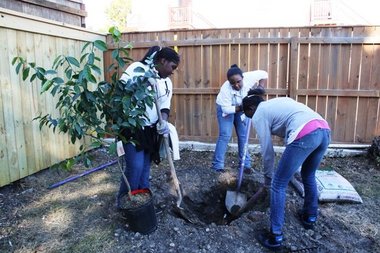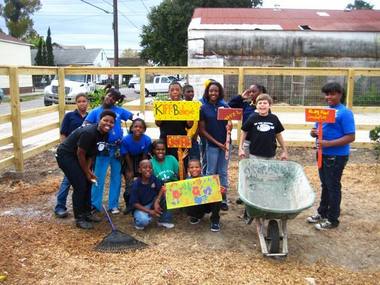Editor’s Note: The following series “Big Easy and the Environment” is a week-long series curated by Lindsay Hardy as part of the Digital Research Internship Program in partnership with ViaNolaVie. The DRI Program is a Newcomb Institute technology initiative for undergraduate students combining technology skillsets, feminist leadership, and the digital humanities.
In a time when we are all wondering what we can do and how things are ever going to get better, we want to remember the amazing organizations and collaborations that happen in New Orleans. When we work together, there is no limit to the levels we can reach. In order to understand how New Orleans takes care of its environment, it is important to represent each community of New Orleans. In this article, Litwin makes sure to highlight how Central City works to clean up its environment, get younger kids involved, and create new and greener spaces.
“Culture Watch: Greening the land in Central City” was originally published on NolaVie on July 7th, 2011, by Sharon Litwin.
As neighborhoods go, Central City is one of the neediest parts of New Orleans. Blighted housing is rampant; per capita income is low; weeds grow many feet high on too many empty lots. But scattered among this incredibly challenged area are some exciting signs of hope: houses that have been rehabbed and painted; small, but energized groups of residents; a forward-looking, cutting-edge neighborhood school – the Mahalia Jackson Center for Early Learning; and, of all things, a fruit orchard.

Jericho Road volunteers plant fruit trees in Central City.
Who would expect to see fledgling grapefruit, lemon, orange and kumquat trees growing in a square plot of land on South Saratoga Street just off LaSalle Street? Surrounded by a redwood fence, this defiant piece of mulched land is covered with a few neat rows of small trees, each with a label identifying the species. It is the latest project of the Jericho Road Episcopal Housing Initiative.
One of 25 winners of 80 applicants in a national competition in the Communities Take Root competition sponsored by Edy’s Fruit Bars and the Fruit Tree Planting Foundation, the Saratoga Street Fruit Orchard is one part of Jericho Road’s vacant land management program.
“We actually started conceptualizing the program in 2010,” explains program manager Alison Ecker, whose post-graduate fellowship from Grinnell College, a longtime partner of Jericho Road’s New Orleans projects, brought her to New Orleans in 2009. Along with more recently arrived colleague Clint Brooks, Ecker is working to attack the vacant lot problem in a city that, she says, is more than one-quarter to one-fifth covered in them.

Jericho Road’s orchard project turns vacant lots into productive acreage.
“In the case of the orchard, our number one priority is community awareness,” she says. “Our hope is that ultimately it will be a community-run public use space. But at this point it is important to have someone out there who will introduce the neighbors to what we’re going to do in that space.”
And that’s where Georgia native Clint Brooks comes in. Just back from earthquake recovery work in Chile and a stint in Guatemala working with a small college in a self-sustaining agriculture project, Clint has hit the ground running with his own homegrown, charming way of making himself known.
“I made a batch of chocolate chip cookies and went around to all the neighbors to introduce myself,” he says.
But should you be thinking that all this is too idealistic in its approach to community building, be assured, it’s not. Ecker and Brooks may be young, but they are experienced community workers who know that connecting on a personal level is what makes projects successful.
“Our vacant land management project is based on one called Philadelphia Green,” Ecker explains. “Their program philosophy is that every time you take a vacant lot, mow it, tear down the derelict building and put a fence around it, you upgrade the neighborhood. For us, that morphed into thinking we should be even more wide-based than that. So we have developed a dual approach: not just the care of vacant lots, but also their use for community urban agriculture.”
So now, almost six years after Hurricane Katrina, Jericho Road’s Central City revitalization efforts have grown from two major efforts – housing development and community development – to three. By acquiring lots for their land bank, then cleaning and greening them with trees and fences, this quiet but successful subsidiary of the Episcopal Diocese of Louisiana is making Central City a better place.
It’s slow, but it’s working. And we hope they never give up.
 NOLAbeings Multimedia artist Claire Bangser created NOLAbeings as a portrait-based story project that marries...
NOLAbeings Multimedia artist Claire Bangser created NOLAbeings as a portrait-based story project that marries...  Voodoo in New Orleans: Reviving history: New Orleans fortune telling This article takes a deep dive into the history of Voodoo in New Orleans, its hybridization with Catholicism, and its present-day place in the city's culture. The author visits fortune-tellers in the French Quarter, using their guidance as a tool for introspection rather than a deterministic predictor of the future. Through her experiences in New Orleans, the author feels a mystical connection to both the past and the future.
Voodoo in New Orleans: Reviving history: New Orleans fortune telling This article takes a deep dive into the history of Voodoo in New Orleans, its hybridization with Catholicism, and its present-day place in the city's culture. The author visits fortune-tellers in the French Quarter, using their guidance as a tool for introspection rather than a deterministic predictor of the future. Through her experiences in New Orleans, the author feels a mystical connection to both the past and the future. 